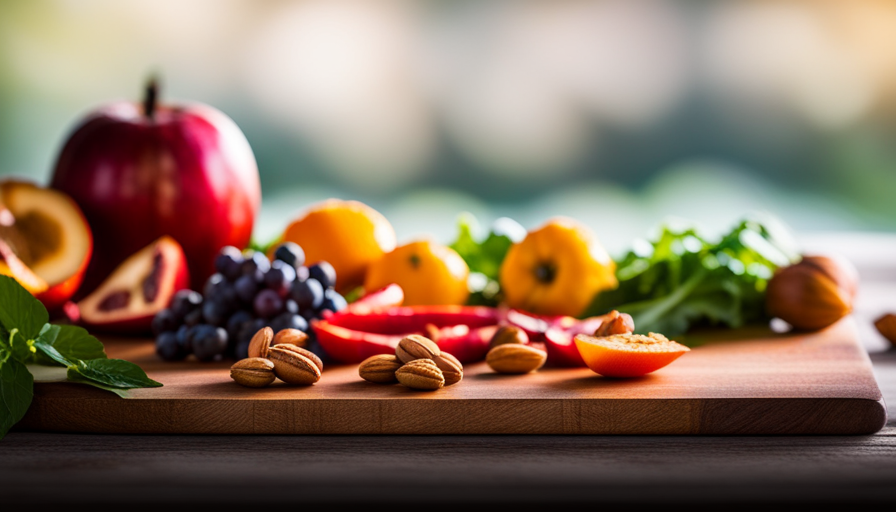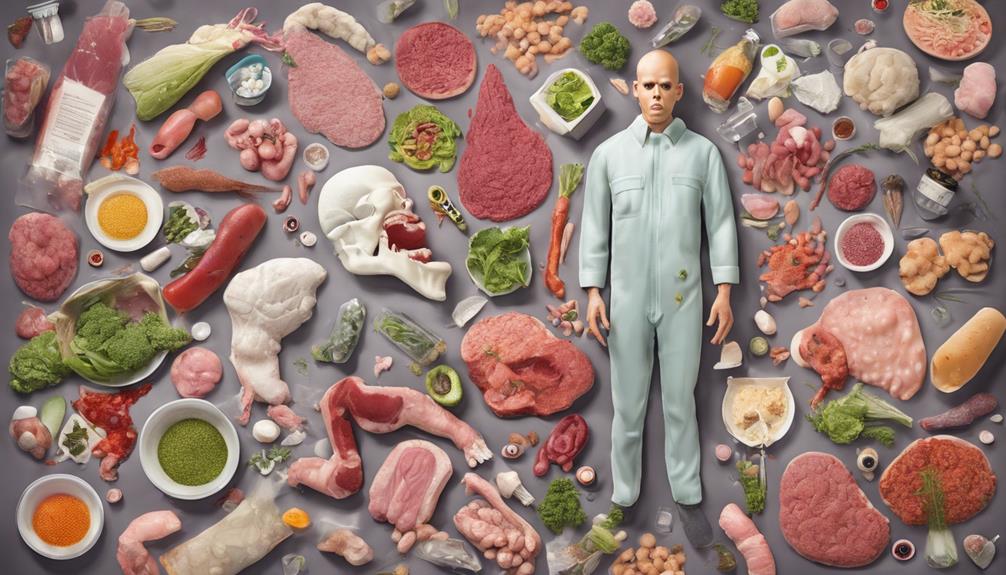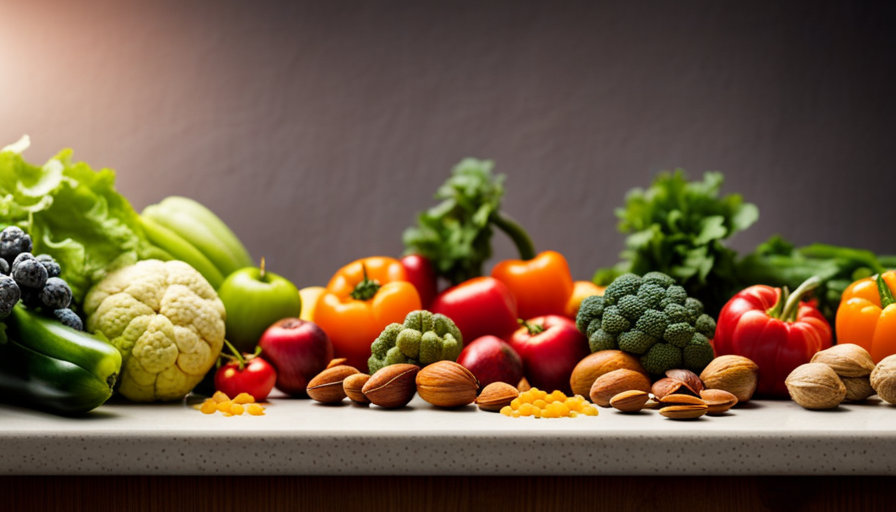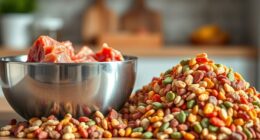Have you ever thought about the potential hazards of consuming raw food, aside from the threat of illness?
While it may seem natural and healthy to consume food in its raw state, there are several factors that can pose a threat to your well-being.
Bacterial contamination is one of the most significant concerns, as raw food can harbor harmful bacteria like Salmonella and E. coli. Additionally, parasitic infections can be contracted through the consumption of raw or undercooked meat or seafood.
Nutritional deficiencies may also arise from an exclusively raw food diet, as certain nutrients are better absorbed when cooked. Digestive issues, potential allergens, and food poisoning are other risks associated with consuming raw food.
Furthermore, some foods, like certain mushrooms or beans, can contain toxins that are neutralized through cooking. Lastly, a lack of variety in a raw food diet may lead to imbalances in essential nutrients.
Therefore, it is important to be aware of these potential dangers and take necessary precautions when choosing to eat raw food.
Key Takeaways
- Potential dangers of eating raw food include bacterial contamination, parasitic infections, nutritional deficiencies, and digestive issues.
- Raw food can expose individuals to harmful bacteria such as Salmonella and E. coli, as well as parasitic infections from undercooked meat or seafood.
- Cooking food helps neutralize toxins in certain raw foods, improves nutrient absorption, and reduces the risk of digestive issues and potential allergens.
- Improper handling, storage, and inadequate cooking of raw food can lead to food poisoning, chemical contaminants, heavy metals, and increased risk of viral infections.
Bacterial Contamination
Eating raw food can be a risky business because it’s like playing bacterial Russian Roulette with your taste buds. While the idea of consuming fresh, uncooked food may seem appealing, it’s important to recognize the potential dangers associated with it.
One major concern is bacterial contamination. When it comes to raw food, proper food handling is crucial. Bacteria such as Salmonella, E. coli, and Campylobacter can easily be present on raw ingredients like meat, poultry, seafood, and even fruits and vegetables. Cross contamination is a significant risk factor in the transmission of these harmful bacteria. For instance, cutting raw chicken on a cutting board and then using the same board without proper cleaning to chop vegetables can lead to the transfer of bacteria from the raw chicken to the vegetables.
To minimize the risk of bacterial contamination, it is essential to adopt safe food handling practices. This includes using separate cutting boards for raw meats and other ingredients, thoroughly washing hands and utensils after handling raw foods, and storing raw and cooked foods separately in the refrigerator. Additionally, cooking raw foods to their recommended internal temperature can effectively kill any harmful bacteria present.
While the allure of raw food may be tempting, the potential dangers of bacterial contamination should not be taken lightly. By practicing proper food handling techniques and being aware of the risks of cross contamination, you can enjoy your meals without compromising your health.
Parasitic Infections
Consuming uncooked ingredients can expose you to parasitic infections, which can have serious health consequences. Parasites are organisms that live on or inside another organism and rely on it for survival. When you eat raw food, you run the risk of ingesting parasites that may be present in the food.
Here are some important points to consider:
-
Prevention methods: To reduce the risk of parasitic infections, it’s essential to properly cook your food. Cooking at high temperatures kills parasites and makes the food safe to consume. Freezing can also kill some parasites, so freezing raw fish or meat before consumption can be a preventive measure. Additionally, practicing good hygiene, such as washing fruits and vegetables thoroughly, can help remove any parasites present on the surface.
-
Long-term health effects: Parasitic infections can lead to a range of health problems. Some parasites can cause digestive issues like diarrhea, abdominal pain, and nausea. Others can affect the liver, lungs, or other organs, leading to more severe complications. In some cases, parasites can even cause chronic infections that may require long-term medical treatment.
It’s crucial to understand the risks associated with consuming raw food and take appropriate measures to prevent parasitic infections. By following proper cooking techniques and practicing good hygiene, you can safeguard your health and avoid the potential long-term consequences of parasitic infections.
Nutritional Deficiencies
One potential consequence of not properly preparing your meals is that you may develop nutritional deficiencies. When you eat raw food, especially in large quantities, you run the risk of missing out on essential nutrients that are typically destroyed or altered during the cooking process. This can have a significant impact on your overall health, as well as your cognitive development.
Cooking food helps to break down its cellular structure, making it easier for your body to digest and absorb nutrients. Raw food, on the other hand, can be harder to digest and may not provide the same level of nutrient absorption. This can lead to deficiencies in important vitamins and minerals, such as vitamin B12, iron, and calcium.
Nutritional deficiencies can have long-term effects on your overall health. For example, a lack of vitamin B12 can result in fatigue, weakness, and nerve damage. Iron deficiency can lead to anemia, causing symptoms such as weakness, pale skin, and shortness of breath. Calcium deficiency can contribute to osteoporosis and increased risk of fractures.
In addition to impacting your physical health, nutritional deficiencies can also affect cognitive development. Adequate intake of nutrients is crucial for brain function and development. For example, omega-3 fatty acids found in fish play a vital role in brain health and can improve cognitive performance.
Not properly preparing your meals and consuming raw food can lead to nutritional deficiencies, which can have long-term effects on your overall health and cognitive development. It’s important to ensure that you’re getting a balanced diet with properly cooked food to obtain the necessary nutrients for optimal health.
Digestive Issues
To avoid digestive issues, make sure you properly prepare your meals and cook your food. Raw food can sometimes be difficult to digest, leading to discomfort and potential health problems.
Food intolerance is a common issue that can arise from consuming raw food. Some individuals may have difficulty digesting certain types of raw food, such as vegetables, fruits, or dairy products. This can result in symptoms like bloating, gas, diarrhea, or stomach pain.
Additionally, raw food may contain certain enzymes that can be difficult for some people to break down. Enzyme deficiencies can hinder the digestion process and prevent the body from properly absorbing nutrients. For example, lactose intolerance is a common enzyme deficiency where individuals lack the enzyme needed to break down lactose, the sugar found in milk. Consuming raw dairy products can exacerbate this condition and lead to digestive discomfort.
Cooking food helps to break down enzymes and make nutrients more easily accessible to the body. Heat also kills potential harmful bacteria that may be present in raw food, reducing the risk of foodborne illnesses. Therefore, it’s important to properly cook your food to avoid digestive issues and ensure optimal nutrient absorption.
Potential Allergens
Are there any common allergens that can cause discomfort and potential health problems? Absolutely. When it comes to eating raw food, there are certain potential allergens that you should be aware of. These allergens can cause cross-reactivity and hidden allergens, which can lead to allergic reactions and other health issues.
Here are four common allergens that you may encounter when consuming raw food:
-
Nuts and seeds: Many people have allergies to nuts and seeds, and consuming them raw can trigger an allergic reaction. Some common examples include peanuts, almonds, and sesame seeds.
-
Dairy products: Milk, cheese, and other dairy products can also be allergenic for some individuals. Raw dairy products may contain higher levels of allergenic proteins, increasing the risk of an allergic reaction.
-
Eggs: Raw eggs can carry a higher risk of salmonella contamination, which can cause food poisoning. Additionally, some individuals may have an allergic reaction to eggs, leading to discomfort and potential health problems.
-
Seafood: Shellfish, such as shrimp, crab, and lobster, are known allergens for many people. Consuming raw seafood increases the risk of exposure to these allergens and can lead to severe allergic reactions.
It’s important to be aware of these potential allergens when consuming raw food. If you have known allergies or sensitivities to any of these items, it’s best to avoid them altogether or consult with a healthcare professional for guidance. Stay informed and take necessary precautions to keep yourself safe and healthy.
Difficulty in Digesting Certain Foods
Now that we have discussed the potential allergens present in raw food, let’s explore another danger of consuming raw food: the difficulty in digesting certain foods. While cooking can break down complex carbohydrates, proteins, and fats, raw foods can contain enzymes that are not readily digestible by our bodies. This can lead to discomfort and digestive issues, especially in individuals with sensitivity to enzymes.
Our digestive system relies on a delicate balance of enzymes to break down the food we consume. When we eat raw food, the enzymes present in the food may not match our body’s enzyme profile, making it challenging for our digestive system to function optimally. This can result in bloating, gas, and diarrhea.
Additionally, raw food can also affect our gut microbiome, which plays a crucial role in our overall health. Our gut microbiome consists of trillions of bacteria that help digest food, produce essential nutrients, and support our immune system. Consuming raw food can disrupt this delicate balance, potentially leading to imbalances in gut bacteria and related health issues.
To better grasp the impact of raw food on our digestive system and gut microbiome, let’s take a closer look at the table below:
| Raw Food Component | Impact on Digestion |
|---|---|
| Complex Carbohydrates | May be difficult to break down, leading to bloating and gas |
| Proteins | Enzymes in raw proteins can be challenging to digest, causing discomfort |
| Fats | Raw fats may be harder to metabolize, potentially leading to digestive issues |
Consuming raw food can present difficulties in digesting certain foods, especially for individuals with sensitivity to enzymes. It can also disrupt the balance of our gut microbiome, impacting our overall digestive health.
Food Poisoning
Consuming undercooked or contaminated food can leave you feeling extremely sick and miserable. Food poisoning is a serious consequence of eating raw or improperly handled food. It occurs when harmful bacteria, viruses, or parasites contaminate the food we eat.
These pathogens can cause a variety of symptoms such as nausea, vomiting, diarrhea, abdominal pain, and fever.
To prevent food poisoning, it’s essential to follow food safety guidelines and practice proper food handling. Firstly, make sure to thoroughly wash your hands with soap and water before handling food. This helps to remove any bacteria or viruses that may be present on your hands.
Secondly, separate raw and cooked foods to prevent cross-contamination. Raw meats, poultry, and seafood should be kept separate from ready-to-eat foods. Additionally, it’s crucial to cook foods to the proper internal temperature to kill any harmful bacteria. Using a food thermometer can help ensure that your food is safe to eat.
Proper storage of perishable foods is also important. Keep refrigerated foods at or below 40°F (4°C) and frozen foods at 0°F (-18°C) or lower. This helps to prevent the growth of bacteria that can cause foodborne illnesses.
By following these food safety guidelines and practicing proper food handling, you can significantly reduce the risk of food poisoning and enjoy your meals without the worry of getting sick.
Potential Toxicity
One potential risk when handling and storing perishable foods improperly is that they can become toxic and cause harm to our health. Raw food, especially if not handled properly, can carry potential chemical contaminants and heavy metals that can be harmful to the body.
For example, fruits and vegetables that are not properly washed can contain pesticide residues which can lead to toxicity if ingested. Additionally, fish and seafood can contain high levels of mercury, a heavy metal that can accumulate in the body and cause neurological damage over time.
In addition to potential chemical exposure, eating raw food also increases the risk of viral infections. Raw meats and seafood, if not cooked properly, can contain harmful bacteria and viruses such as Salmonella, E. coli, and norovirus. These pathogens can cause food poisoning and lead to symptoms such as diarrhea, vomiting, and abdominal pain.
To minimize the potential risks associated with eating raw food, it’s important to handle and store perishable foods properly. This includes washing fruits and vegetables thoroughly, cooking meats and seafood to the appropriate temperature, and practicing good hygiene during food preparation. By following these guidelines, you can reduce the chances of potential chemical exposure and the risk of viral infections associated with consuming raw food.
Increased Risk for Foodborne Illnesses
Be aware that mishandling and storing perishable foods improperly puts you at an increased risk for getting sick from harmful bacteria and viruses.
When you consume raw food, you’re exposing yourself to potential foodborne illnesses. Raw foods, such as fruits, vegetables, and meats, can be contaminated with harmful pathogens like Salmonella, E. coli, and Listeria.
The risk factors for foodborne illnesses include inadequate cooking, improper storage temperatures, cross-contamination, and poor personal hygiene.
To reduce the risk of foodborne illnesses, it’s essential to take preventive measures. First, make sure to wash your hands thoroughly with soap and water before and after handling raw food. Additionally, maintain a clean and sanitized kitchen environment by regularly cleaning countertops, cutting boards, and utensils.
Separate raw foods from ready-to-eat foods to prevent cross-contamination. Cook foods to their recommended internal temperatures, ensuring that they reach a level that kills any harmful bacteria. Refrigerate perishable foods promptly and store them at the correct temperature to slow down bacterial growth.
By following these prevention measures, you can significantly reduce the risk of foodborne illnesses associated with consuming raw food.
Stay informed about safe food handling practices to protect yourself and your loved ones from potential health risks.
Lack of Variety in Diet
Now that we’ve discussed the increased risk for foodborne illnesses associated with eating raw food, let’s explore another potential danger: the lack of variety in the diet. When you choose to eat raw food exclusively, you limit your options and may find it challenging to meet your nutritional needs.
Raw food diets often consist of fruits, vegetables, nuts, and seeds, which may not provide the same variety of nutrients as a balanced diet that includes cooked foods. Without the option to cook or prepare food in different ways, you may miss out on essential vitamins, minerals, and other beneficial compounds.
To illustrate this point, let’s take a look at a comparison between a typical cooked meal and a raw food meal:
| Cooked Meal | Raw Food Meal |
|---|---|
| Grilled chicken with mixed vegetables and quinoa | Salad with raw vegetables, fruits, and nuts |
As you can see, the raw food meal offers limited options compared to the cooked meal. Furthermore, the lack of cooking can affect the taste and texture of food, which may not align with your taste preferences.
While incorporating raw foods into your diet can be beneficial, it’s important to ensure you have a balanced and diverse eating plan to meet your nutritional needs.
Frequently Asked Questions
How can I minimize the risk of bacterial contamination when consuming raw food?
To minimize the risk of bacterial contamination when consuming raw food, there are a few important steps you can take. First, make sure to wash your hands thoroughly before handling any raw food.
Additionally, separate raw foods from ready-to-eat foods to avoid cross-contamination. Properly storing raw food at the correct temperature is also crucial.
Did you know that a recent study found that 48% of foodborne illnesses were caused by mishandling of raw food? So, it’s essential to follow these guidelines to keep yourself safe.
What are some common symptoms of parasitic infections caused by eating raw food?
Common symptoms of parasitic infections caused by eating raw food include diarrhea, nausea, vomiting, abdominal pain, and fatigue. If you’re experiencing these symptoms, it’s important to seek medical attention. There are various treatment options available for parasitic infections, including medications that target specific parasites.
To prevent such infections, it’s crucial to follow proper food handling and preparation practices. This includes washing fruits and vegetables thoroughly, cooking meat to appropriate temperatures, and avoiding consumption of raw or undercooked foods.
Are there any specific nutritional deficiencies that can occur from a diet consisting of mostly raw food?
If you have a diet consisting mostly of raw food, there’s a risk of nutritional deficiencies. Raw food can be lacking in certain nutrients that are essential for your health.
For example, cooking helps to break down the cell walls of plants, making it easier for your body to absorb nutrients like vitamins and minerals. Additionally, some nutrients, like lycopene in tomatoes, are more bioavailable when cooked.
Therefore, relying solely on raw food may put you at risk for deficiencies and negatively impact your overall health.
Can eating raw food lead to long-term digestive issues?
Eating raw food can potentially lead to long-term digestive system problems. Raw food may contain harmful bacteria, such as E. coli and Salmonella, which can cause foodborne illnesses. These illnesses can lead to symptoms like diarrhea, vomiting, and abdominal pain.
Additionally, raw food may be more difficult to digest, as cooking helps break down food and make it easier for our bodies to absorb nutrients. Therefore, consuming a diet high in raw food may increase the risk of digestive issues and negatively impact long-term health.
Are there any precautions to take in order to prevent potential allergic reactions from consuming raw food?
To prevent potential allergic reactions from consuming raw food, there are a few precautions you can take. First, make sure to thoroughly wash all fruits and vegetables before consuming them raw. This helps remove any potential allergens or contaminants.
Additionally, be cautious of cross-contamination risks in raw food preparation. Use separate cutting boards and utensils for raw foods to avoid mixing with allergens from other ingredients.
By following these steps, you can minimize the risk of allergic reactions from consuming raw food.
What are the potential dangers of consuming raw eggs in a daily protein shake?
Consuming a daily protein shake with raw eggs may pose potential dangers such as salmonella infection. Raw eggs can contain harmful bacteria that can lead to food poisoning. It’s important to consider the risks and ensure that eggs are properly cooked to minimize the chance of illness.
Conclusion
In conclusion, it’s important to be aware of the potential dangers of consuming raw food. Bacterial contamination and parasitic infections are real risks that can lead to serious illnesses. Additionally, nutritional deficiencies and digestive issues can arise from a diet lacking in cooked foods.
It’s crucial to consider potential allergens and the risk of food poisoning as well. Remember, ‘an ounce of prevention is worth a pound of cure.’ So, ensure you practice food safety measures and cook your food thoroughly to reduce the risk of these dangers.










